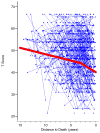Decline in life satisfaction in old age: longitudinal evidence for links to distance-to-death
- PMID: 18361663
- PMCID: PMC3482430
- DOI: 10.1037/0882-7974.23.1.154
Decline in life satisfaction in old age: longitudinal evidence for links to distance-to-death
Abstract
Using 12-year longitudinal data from deceased participants of the Berlin Aging Study (N = 414; age 70-103 years, at first occasion; M = 87 years, SD = 8.13), the authors examined whether and how old and very old individuals exhibit terminal decline in reported life satisfaction at the end of life. Relative to age-related decline, mortality-related decline (i.e., distance-to-death) accounted for more variance in interindividual differences in life satisfaction change and revealed steeper average rates of decline, by a factor of 2. By applying change-point growth models, the authors identified a point, about 4 years before death, at which decline showed a two-fold increase in steepness relative to the preterminal phase. For the oldest old (85+ years), a threefold increase was observed. Established mortality predictors, including sex, comorbidities, dementia, and cognition, accounted for only small portions of interindividual differences in mortality-related change in life satisfaction. The authors conclude that late-life changes in subjective well-being are related to mechanisms predicting death and suggest routes for further inquiry.
(c) 2008 APA, all rights reserved.
Figures



Comment in
-
[Psychological functioning and aging. Learning from longitudinal studies].Rev Esp Geriatr Gerontol. 2010 Nov-Dec;45(6):350-7. doi: 10.1016/j.regg.2010.09.001. Epub 2010 Nov 13. Rev Esp Geriatr Gerontol. 2010. PMID: 21075486 Review. Spanish.
References
-
- Akaike H. Information theory and an extension of the maximum likelihood principle. In: Petrov BN, Csaki F, editors. Proceedings of the Second International Symposium on Information Theory. Budapest, Bulgaria: Akademiai Kiado; 1973. pp. 267–281.
-
- Anstey K, Mack HA, von Sanden C. The relationship between cognition and mortality in patients with stroke, coronary heart disease, or cancer. European Psychologist. 2006;11:182–195.
-
- Bäckman L, MacDonald SWS. Death and cognition: Synthesis and outlook. European Psychologist. 2006;11:224–235.
-
- Baltes PB. On the incomplete architecture of human ontogeny: Selection, optimization, and compensation as foundation of developmental theory. American Psychologist. 1997;52:366–380. - PubMed
-
- Baltes PB, Baltes MM, editors. Successful aging: Perspectives from the behavioral sciences. New York, NY: Cambridge University Press; 1990.

